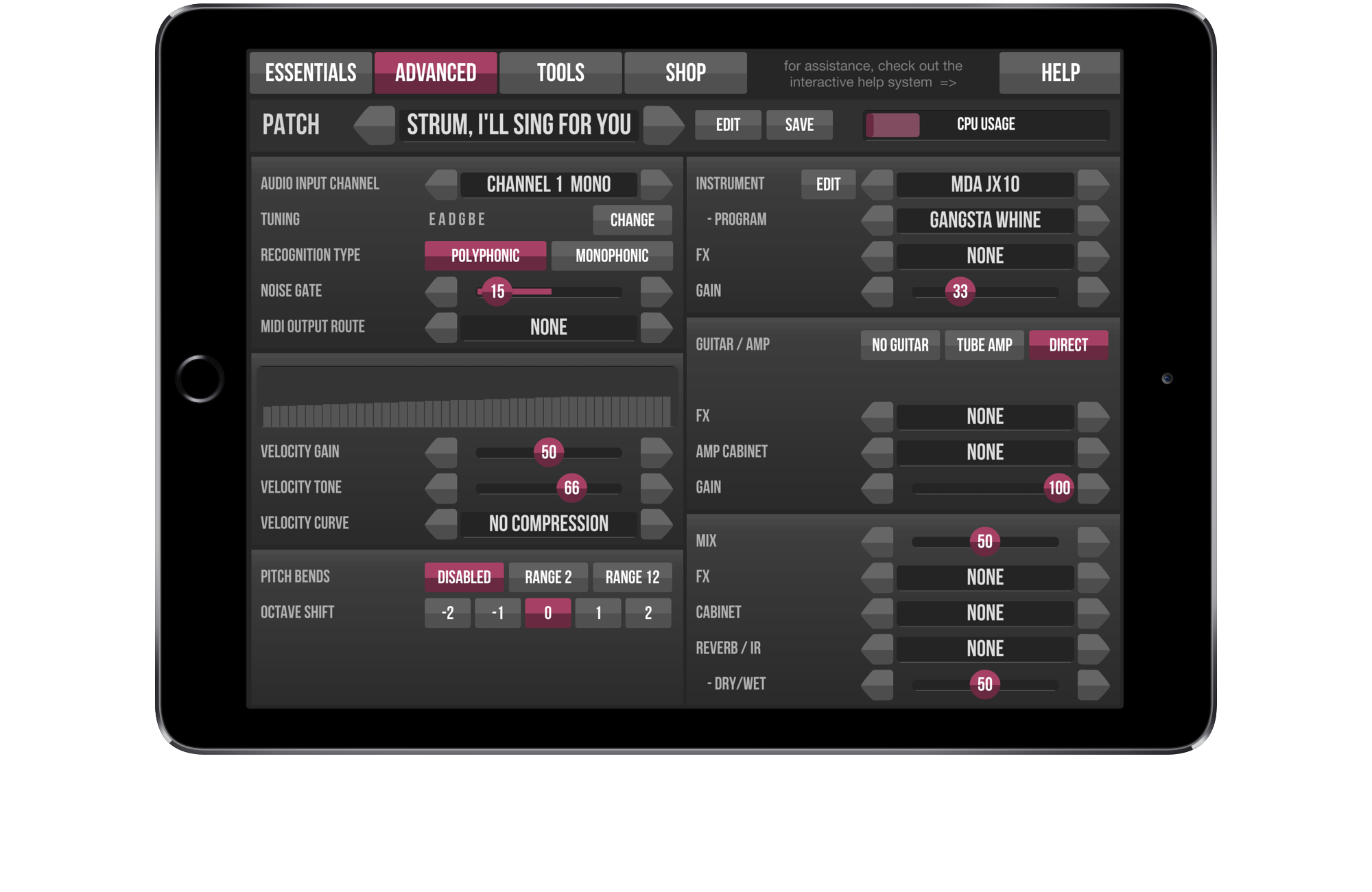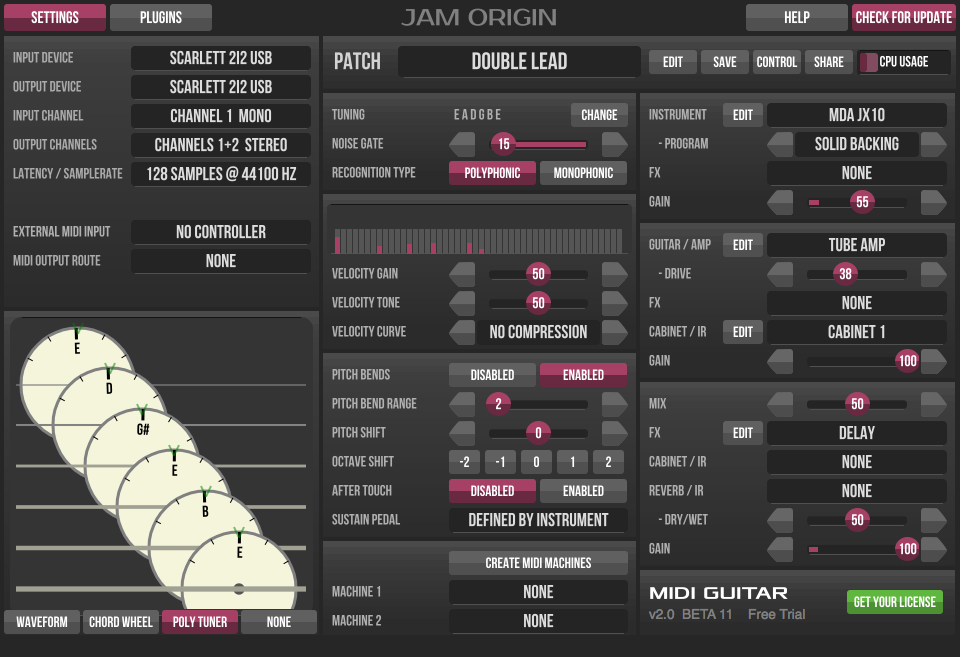20 Sep Gig Performer and JamOrigin’s MIDI Guitar 2 plugin
Jam Origin’s polyphonic MIDI Guitar and monophonic MIDI Bass programs have dramatically lowered the barrier to entry in this field, and have done so in unique and outstanding fashion. While one might expect the MIDI Bass offering to be the subject of review in a bass-specific magazine, I’ll actually be focusing on MIDI Guitar 2 and tandem.
MIDI Guitar 2 from Jam Origin is a wonderful plugin if you need to convert your guitar sound into MIDI and subsequently to any sound you want limited only by your collection of instrument plugins.
I have been using both MIDI Guitar 1 and 2.
We were recently in touch with Jam Origin and we received an important piece of information regarding the usage of MIDI Guitar 2 and Gig Performer on OS X.
The VST version works as expected. You insert it into your rackspace, connect your guitar to its audio input channel and your MIDI data comes out of its MIDI port. You can of course do this in as many rackspaces as you want.

JamOrigin is about to release v2 of its MIDI Guitar audio to MIDI signal converter in standalone and plug-in editions for Mac OS X and Windows. MIDI Guitar 2 is expected in the next few days, after two years of development. MIDI Guitar 2 is a major milestone for us, but its also just another step in our overall pursuit to keep pushing the audio recognition technology that MIDI Guitar builds upon. In the next weeks you will see a series of incremental updates of MIDI Guitar 2, until we are. How to use JamOrigins MIDI Guitar with Cockos Reaper Get MIDI Guitar here: http://www.jamorigin.com/midi-guitar/Windows-Mac/. Jam Origin’s polyphonic MIDI Guitar and monophonic MIDI Bass programs have dramatically lowered the barrier to entry in this field, and have done so in unique and outstanding fashion. While one might expect the MIDI Bass offering to be the subject of review in a bass-specific magazine, I’ll actually be focusing on MIDI Guitar 2 and tandem.
However, the AU version does not produce MIDI on the MIDI out channel. Instead, it creates a new virtual MIDI Output port and you will then need to create a corresponding MIDI In Block to receive MIDI from the MIDI Guitar plugin. Doable but rather extra unnecessary work.
In short, prefer the VST version over the AU version and just insert a MIDI Guitar 2 VST plugin into a rackspace when you need it.
MIDI Guitar 2 plugin (there’s a free trial) can be downloaded from Jam Origin’s website: https://www.jamorigin.com
MIDI Guitar 2 for iOS was just released on App Store. It is is now almost a 1:1 port of the desktop/VST/AU version.
Tracking is very fast and more responsive and sensitive than most (hardware-) solutions which means it picks up articulations very well. However, its slightly slower than the desktop/plugin version of MIDI Guitar 2 due to a fixed buffer size of 6 milliseconds and eventually iOS’s audio processing may be slightly slower than a carefully configured audio desktop/laptop.
The App also inherit most features of the desktop/plugin version. Most notably it has pitch bends, better velocity handling and a full stack of guitar effects and an amp sim with more Amp Cabinet responses than any other amp-sim app we know of. There is even a polyphonic tuner and an interactive chord wheel to assist with chord progressions, both free of charge.
IMPORTANT: MIDI Guitar 2 is very CPU hungry – especially if you add amp and effects. Luckily Apples newer chips are also blazing fast. Using MIDI Guitar’s built-in synths and guitar amp and effects together you need a new iOS Device (iPad Air or iPhone 6), but if you only use the MIDI output to play external synth external apps (including Garageband), you can get away with an iPad 4 or IPhone 5. MIDI Guitar’s internal modules are more CPU-hungry because it will process everything on one CPU core. Contrary, if you play an external synth you can utilise both CPU cores and sustain higher loads. We will try to improve CPU efficiency further in the future.
What’s missing still
1. AudioBus, and Apples new iOS AudioUnits (v3) is the next thing we will look into.
Please mind that, MIDI Guitar doesn’t have any compatibility issues with AudioBus that we are aware of, and happily run alongside your AudioBus setup, if you have the horsepower.
2. MIDI Inputs (from controllers or other external sources) is missing, compared to the desktop version. Please mind that usually you want to hook a MIDI controller up to the synth, not to MIDI Guitar, and thus MIDI inputs usually aren’t really needed.
3. Further CPU optimisations to ease the load on older iDevices.
4. Some nice Reverbs will be added, hopefully a system much like the Amp Cabinet Mining.
Pricing
Old customers: The old In-App-Purchase translates over to the new version and if you are an old customer, you can of course use MIDI Guitar you’ve always done, with the improved tracking. All you need to do is to click “Restore” in the Shop to restore the old purchase. This still unlocks the MIDI outputs (Virtual-MIDI, Cable-MIDI and WIFI-MIDI)
New customers will have to get the same in-app purchase to unlock the MIDI outputs and the price remain $20. For both new and old customers there is a new In-App purchase which unlocks all the features of Advanced mode (including the built in synths, pitch bends, etc..), priced at $10.
Everything is of course free to evaluate, Many features (including a polyphonic tuner and interactive chord wheel) are all free to use as much as you want.

Download
Get it now at iTunes / App Store. It’s free to try.
… and please leave us a nice rating while you are there – it’s the best way to support developments and help us out.
Support
Please first read the built-in help system. Is should serve as an introduction and also a reference for most settings.
Jam Origin Midi Guitar 2
Then write to our support, using the form on this website. Please don’t use the app review system for support issues (we have no way to get back to you this way).
More information
For an general introduction please see the MIDI Guitar 2 product page. Lots of user videos here.
Jam Origin Midi Guitar 2 Crack
Stay updated ? – sign up for news.
